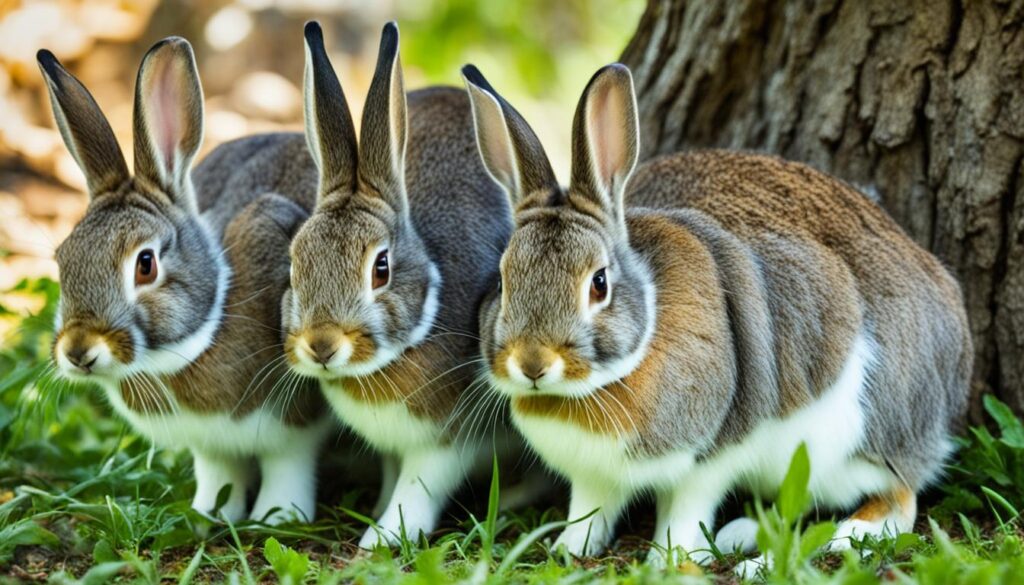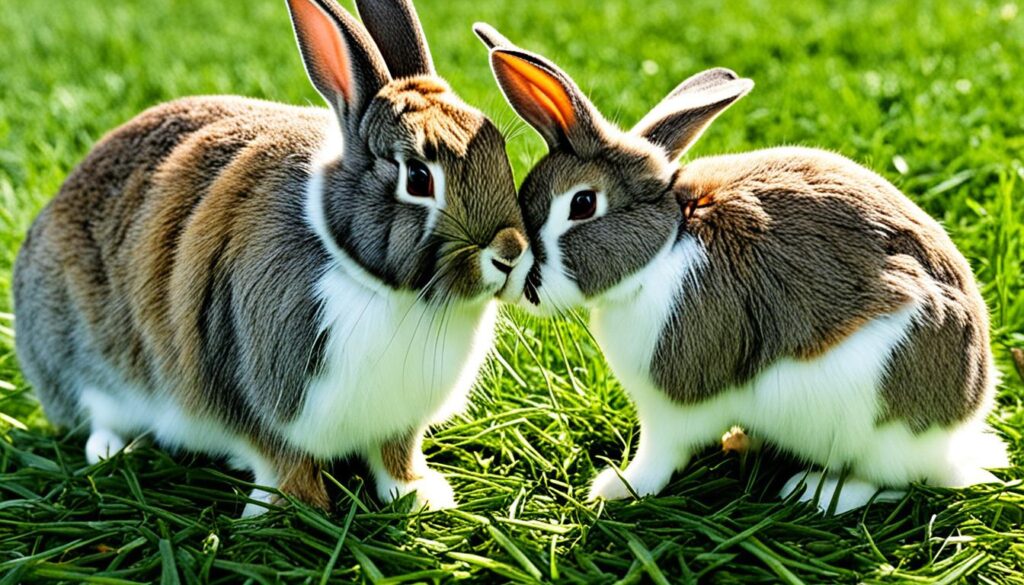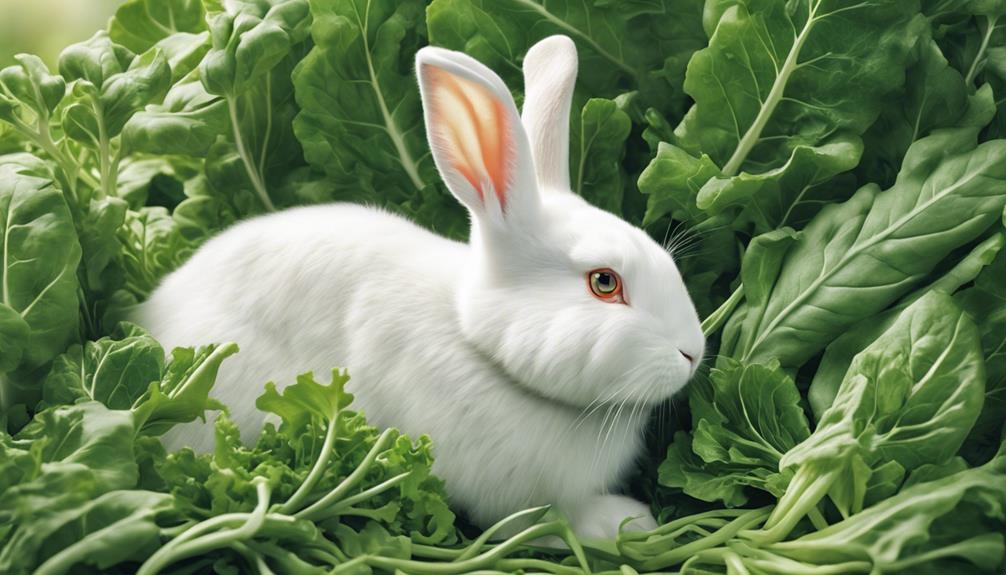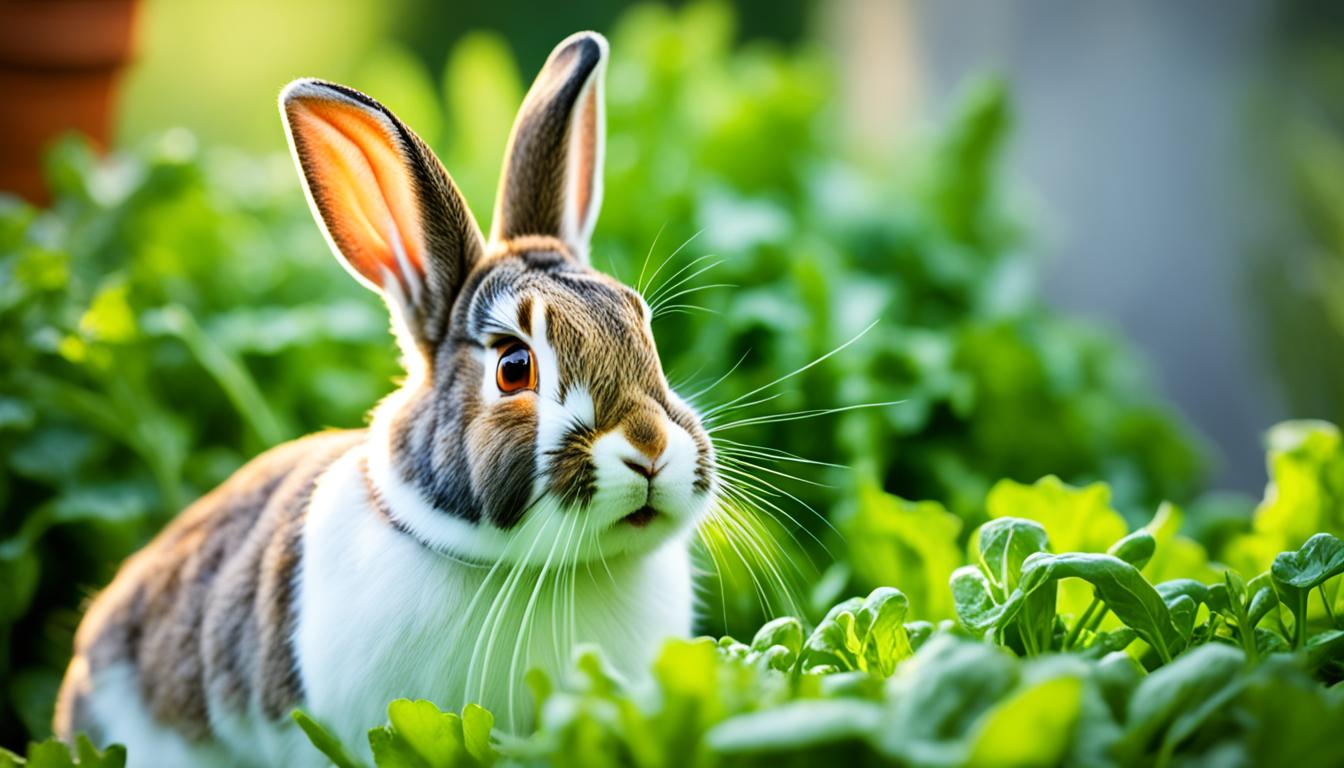Did you know that wild rabbits keep their nails naturally trimmed? Unlike their domestic counterparts, wild rabbits have ways to keep their nails short through activities like digging and running on tough surfaces. However, pet rabbits need to have their nails trimmed every 6-8 weeks to avoid overgrowth and possible health problems.
In this article, we will explore the reasons behind wild rabbits’ naturally short nails and provide you with tips on how to keep your pet rabbit’s nails short without cutting. By mimicking wild rabbit behavior and implementing the right techniques, you can ensure your furry friend’s paw health and well-being.
Key Takeaways:
- Wild rabbits naturally keep their nails short through activities like digging and running on hard surfaces.
- Pet rabbits require regular nail trimming every 6-8 weeks to prevent overgrowth.
- Mimicking wild rabbit behavior by providing a hard surface for your pet can contribute to shorter nails.
- Consulting with your vet and using the proper tools and techniques is crucial for successful nail trimming.
- Regular nail trimming is essential for maintaining the health and comfort of your pet rabbit.
Why Do Wild Rabbits Have Short Nails?
Wild rabbits, like European rabbits, have naturally short nails due to their unique lifestyle and behaviors. Let’s explore the reasons behind their short nails and how these factors contribute to their natural nail maintenance.
Natural Nail Erosion through Digging and Living in Burrows
Wild rabbits spend a significant amount of time digging burrows and living in them. This constant digging wears down their nails, gradually eroding them and keeping them short. As they navigate their underground homes, their nails naturally come into contact with the soil and other abrasive surfaces, helping to maintain an optimal nail length.
Running on Hard Surfaces in the Wild
Wild rabbits frequently run on hard surfaces, such as rocky terrain or open fields. This regular activity naturally wears down their nails, effectively trimming them. The friction between their nails and these rough surfaces acts as a natural nail filing mechanism, preventing excessive growth and ensuring their nails remain short and manageable.

“Wild rabbits’ active lifestyle in their natural habitat contributes to their naturally short nails.”
Wild rabbits’ active lifestyle and natural behaviors play a vital role in maintaining their short nails. Through digging and living in burrows, running on hard surfaces, and engaging in other activities inherent to their wild environment, these rabbits naturally wear down their nails, eliminating the need for regular nail trimming.
Nail Trimming for Pet Rabbits
Pet rabbits require regular nail trimming to ensure their nails stay at a manageable length, preventing any potential harm to themselves and their owners. It is recommended to trim their nails every 6-8 weeks, although more frequent trimming may be necessary for some rabbits.
Some rabbits may initially resist having their nails trimmed, but with practice and patience, they can become more comfortable with the process. It’s important to create a calm and safe environment during nail trimming sessions to help alleviate any stress or anxiety.
Consulting with your veterinarian is crucial as they can provide guidance on the proper technique for trimming your pet rabbit’s nails. They can also assist you in identifying the appropriate tools to use, ensuring a safe and effective nail trimming experience.
| Nail Trimming Tips for Pet Rabbits |
|---|
| Handle your rabbit gently but firmly during the nail trimming process. |
| Start with short trimming sessions and gradually increase the duration as your rabbit becomes more comfortable. |
| Use treats as positive reinforcement to reward your rabbit for good behavior during the nail trimming. |
| Keep a styptic powder or cornstarch on hand in case you accidentally cut the quick, which can stop any bleeding. |
Remember, maintaining short nails is vital for the health and well-being of your pet rabbit. By following proper nail trimming techniques and seeking guidance from your veterinarian, you can ensure your rabbit stays happy, healthy, and comfortable.
Mimicking Wild Rabbit Behavior
To help keep your pet rabbit’s nails short, it’s important to mimic their natural behavior in the wild. Wild rabbits naturally wear down their nails through activities like digging and running on hard surfaces. By providing a hard surface for your pet rabbit to move around on, you can mimic these behaviors and help maintain their nail length.

Allowing your rabbit to naturally wear down their nails on a hard surface can help prevent overgrowth and the need for frequent nail trimming. A simple and effective way to provide a hard surface for your rabbit is to place a slab of plywood in their living space. This allows them to naturally file their nails down as they hop and play.
Mimicking wild rabbit behavior has multiple benefits. Not only does it help keep your pet rabbit’s nails at a proper length, but it also provides them with mental and physical stimulation. Just like in the wild, the opportunity to dig and run on a hard surface helps satisfy their natural instincts.
The Challenges of Filing Nails
Filing rabbit nails to maintain their length can present several challenges for both the rabbit and the person doing the nail trimmings. Unlike clipping, filing requires a significant amount of time and effort to achieve the desired nail length, making it a less practical option. Here are some of the challenges you may encounter when filing rabbit nails:
- Time-consuming: Filing a rabbit’s nails takes longer compared to clipping. It requires patience and steady hands to file each nail to the desired length.
- Stressful for rabbits: Rabbits may find the constant buzzing or grinding sound of the nail file distressing. The unfamiliar sensation and prolonged handling can cause stress and discomfort for them.
- Risk of injury: Filing nails can increase the risk of accidental injury to the rabbit. If the nail file slips or if excessive pressure is applied, it can cause pain or damage to the sensitive nail bed.
- Tedious process: Filing each nail individually can become monotonous and tiresome, especially if your rabbit is uncooperative or anxious during the nail trimming session.
Quotable: Expert’s Insight
“Filing rabbit nails can be a more challenging option compared to clipping. It requires a steady hand, patience, and a cooperative rabbit. Many pet owners find that clipping the nails and providing a hard surface for natural wear and tear is generally more effective and less stressful for rabbits.”
| Method | Advantages | Disadvantages |
|---|---|---|
| Clipping Nails |
|
|
| Filing Nails |
|
|

Despite these challenges, many rabbit owners find that clipping nails and providing a hard surface for natural wear and tear is a more practical and effective solution for maintaining appropriate nail length. It is important to prioritize your rabbit’s well-being and choose the method that is least stressful for both of you.
Building Trust and Familiarity
Building trust and familiarity with your pet rabbit is crucial for successful nail trimming. By creating a bond and establishing a sense of security, you can help alleviate your rabbit’s anxiety and make the grooming process more comfortable for both of you.
Start by gently touching your rabbit’s feet during regular handling sessions. Gradually increase the amount of contact over time, ensuring your rabbit feels safe and secure throughout the process. This gradual approach allows your rabbit to become more accustomed to having their paws touched, reducing apprehension during nail trimming.
“Trust takes time and patience, but the rewards are worth it.”
Offering treats can further reinforce positive associations with nail trimming. Provide small, rabbit-safe treats before, during, and after each session as a reward for good behavior. This positive reinforcement helps create a positive and calm environment, making your rabbit feel more at ease.

| Steps to Building Trust with Your Pet Rabbit |
|---|
|
Proper Tools for Nail Trimming
When it comes to nail trimming for your rabbits, using the proper tools is essential. This ensures a safe and effective trimming process without causing any harm or discomfort to your furry friend. Here are some recommendations:
Nail Trimmers for Small Animals
It’s important to choose nail trimmers specifically designed for small animals like rabbits. These trimmers are specifically crafted to accommodate the size and structure of their nails. Avoid using dog nail trimmers, as they may not be suitable for rabbits and can result in uneven cuts or injuries.
Cat Nail Trimmers
Another option that works well for rabbits is cat nail trimmers. They are usually small enough to provide precise trimming without causing any stress to your pet. Cat nail trimmers are readily available at pet stores and online retailers, making them easily accessible for your grooming needs.

Recommended Brands and Retailers
When it comes to purchasing nail trimmers for your rabbits, reputable pet stores like Petco and Petsmart offer a variety of options. These brands provide high-quality tools that are designed to ensure the safety and comfort of your pets during nail trimming sessions.
Summary
Investing in the proper tools for nail trimming is crucial to maintain the well-being of your rabbits. By using nail trimmers designed for small animals and choosing reputable brands, you can confidently trim your pet’s nails efficiently and without causing any discomfort.
How to Trim Rabbit Nails
When it comes to trimming our rabbits’ nails, it’s essential to follow the right technique to ensure their safety and comfort. Here are some helpful tips:
- Flipping your rabbit: Practice flipping your rabbit over onto their back and holding them gently but firmly on your lap. This position allows for better access to their nails and makes trimming easier.
- Get a helper: Having an extra set of hands can be beneficial, especially if you’re new to nail trimming. A helper can assist in holding your rabbit and keeping them calm during the process.
- Trim in small increments: Cut your rabbit’s nails in small increments to avoid accidentally cutting the quick. The quick is the blood vessel inside the nail, so it’s important to be cautious and take your time.
- Stop bleeding: If you accidentally cut the quick and your rabbit starts bleeding, don’t panic. Apply some flour or corn starch to the affected area to help stop the bleeding. Keep your rabbit calm and offer them gentle reassurance.
Remember, nail trimming may require practice and patience. By following these techniques, we can ensure that our rabbits’ nails are properly maintained, keeping them happy and healthy.

Importance of Regular Nail Trimming
Regular nail trimming plays a crucial role in the overall well-being of rabbits. By keeping their nails short, we can prevent potential injuries to their nails, leg bones, and joints. Long nails can cause unnecessary stress on the joints, leading to discomfort and increasing the risk of injury.
To ensure the utmost care for our furry friends, it is essential to pay special attention to the dewclaw. By keeping it properly trimmed, we can prevent any discomfort or potential injury that may arise from its overgrowth.
The Health Benefits of Regular Nail Trimming
Trimming your rabbit’s nails regularly can provide several health benefits:
- Promotes proper posture and gait: Short nails help maintain the natural alignment of the legs and feet, enabling rabbits to move around comfortably.
- Prevents nail-related health issues: Long nails can curl, dig into the skin, or even break, leading to infections or other health complications.
- Reduces the risk of injury: Short nails minimize the chances of rabbits snagging or getting their nails caught on objects, reducing the risk of painful injuries.
- Eases grooming: Trimming nails prevents excessive scratching and reduces the likelihood of self-inflicted wounds during grooming.
- Enhances bonding: Regular nail trimming sessions provide an opportunity for you to bond with your rabbit while ensuring their well-being.
Remember, maintaining short, well-trimmed nails is an integral part of rabbit care and contributes to their overall happiness and quality of life.
| Benefits of Regular Nail Trimming | |
|---|---|
| Promotes proper posture and gait | ✓ |
| Prevents nail-related health issues | ✓ |
| Reduces the risk of injury | ✓ |
| Eases grooming | ✓ |
| Enhances bonding | ✓ |

Regular nail trimming is not just a matter of aesthetics; it is a crucial aspect of proactive rabbit care. By maintaining short nails, we can ensure our rabbits’ comfort and reduce the risk of potential health issues. Let’s prioritize regular nail trimming to provide our furry companions with the best possible care.
Overcoming Fear and Mistakes
Nail trimming can be a source of fear and anxiety, especially for beginners. It’s natural to worry about accidentally injuring your beloved rabbit. However, with the right approach and practice, you can overcome these challenges and make the nail trimming process easier for both you and your furry friend.
“It’s common for beginners to feel nervous about nail trimming and worry about accidentally injuring their rabbits.”
One common concern is cutting the quick, the sensitive blood vessel inside the nail. While accidentally cutting the quick may cause some initial discomfort for the rabbit, rest assured that it heals quickly, and they will forget about it in no time. Remember, mistakes happen, but they shouldn’t discourage you from taking care of your rabbit’s nail health.
“With practice, nail trimming will become easier, and mistakes will become less common.”
Like any skill, nail trimming improves with practice. The more you trim your rabbit’s nails, the more comfortable and confident you’ll become. Start by trimming a small portion of the nail at a time, and gradually increase the amount as you gain experience. Over time, you’ll develop a steady hand and a better understanding of your rabbit’s unique nail needs.
To ensure a successful nail trimming session, it’s essential to stay calm and composed. Rabbits are highly intuitive animals and can sense if you’re anxious or hesitant. Create a soothing environment by finding a quiet, well-lit area, and play relaxing music if it helps. Maintaining a sense of calm and confidence will help keep your rabbit at ease during the process.

Tips for Overcoming Fear and Making Nail Trimming Easier:
- Take deep breaths and relax before starting the nail trimming process.
- Use treats and positive reinforcement to reward your rabbit’s cooperation.
- Introduce your rabbit to the nail trimmers gradually, allowing them to sniff and investigate the tool beforehand.
- Practice handling your rabbit’s paws and feet regularly, even when you’re not trimming their nails. This will help them get accustomed to the sensation and build trust.
- Consider seeking assistance from a professional, such as a veterinarian or a professional groomer, for guidance and support.
Remember, don’t be too hard on yourself if you make a mistake or if your rabbit gets a little anxious during the process. Mistakes happen, and it’s all part of the learning curve. With patience, practice, and a lot of love, you’ll become more proficient at nail trimming, ensuring your rabbit’s nails stay healthy and comfortable.
Conclusion
In conclusion, regular nail trimming is essential for maintaining the health and comfort of your pet rabbits. By mimicking wild rabbit behavior and providing a hard surface for natural nail wear, you can help keep their nails short and prevent overgrowth. Building trust with your rabbit, using proper tools, and practicing the right technique are also crucial for successful nail trimming.
Remember to consult with your vet for specific guidance on caring for your pet rabbit’s nails. They can provide expert advice and demonstrate the proper nail trimming technique tailored to your rabbit’s needs. With proper care and attention, you can keep your rabbits’ nails in optimal condition, ensuring their overall well-being and happiness.
Take the proactive approach in rabbit nail care by incorporating regular nail trimming into their routine. It may take some practice and patience, but it’s worth it to prevent discomfort and potential injuries caused by overgrown nails. So, let’s prioritize the health and happiness of our furry friends and keep their nails in check.










